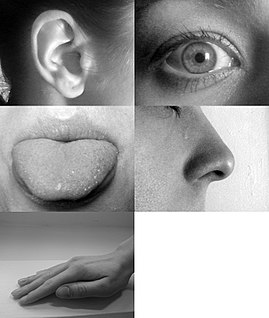Sense
|
|
It has been suggested that this article be merged into Sensory nervous system. (Discuss) Proposed since December 2016. |
|
|
|
This article has multiple issues. Please help improve it or discuss these issues on the talk page. (Learn how and when to remove these template messages)
|
Humans have a multitude of senses. Sight (vision), hearing (audition), taste (gustation), smell (olfaction), and touch (somatosensation) are the five traditionally recognized senses. The ability to detect other stimuli beyond those governed by these most broadly recognized senses also exists, and these sensory modalities include temperature (thermoception), kinesthetic sense (proprioception), pain (nociception), balance (equilibrioception), vibration (mechanoreception), and various internal stimuli (e.g. the different chemoreceptors for detecting salt and carbon dioxide concentrations in the blood). However, what constitutes a sense is a matter of some debate, leading to difficulties in defining what exactly a distinct sense is, and where the borders between responses to related stimuli lay.
Other animals also have receptors to sense the world around them, with degrees of capability varying greatly between species. Humans have a comparatively weak sense of smell and a stronger sense of sight relative to many other mammals while some animals may lack one or more of the traditional five senses. Some animals may also intake and interpret sensory stimuli in very different ways. Some species of animals are able to sense the world in a way that humans cannot, with some species able to sense electrical and magnetic fields, and detect water pressure and currents.
Contents
- 1 Definition
- 2 Traditional senses
- 3 Non-traditional senses
- 4 Perception not based on a specific sensory organ
- 5 Non-human senses
- 6 Culture
- 7 See also
- 8 References
- 9 External links
Definition
A broadly acceptable definition of a sense would be “A system that consists of a group of sensory cell types that responds to a specific physical phenomenon, and that corresponds to a particular group of regions within the brain where the signals are received and interpreted.” There is no firm agreement as to the number of senses because of differing definitions of what constitutes a sense.
The senses are frequently divided into exteroceptive and interoceptive:
- Exteroceptive senses are senses that perceive the body’s own position, motion, and state, known as proprioceptive senses. External senses include the traditional five: sight, hearing, touch, smell and taste, as well as thermoception (temperature differences) and possibly an additional weak magnetoception (direction).[1] Proprioceptive senses include nociception (pain); equilibrioception (balance); proprioception (a sense of the position and movement of the parts of one’s own body).
- Interoceptive senses are senses that perceive sensations in internal organs.
Non-human animals may possess senses that are absent in humans, such as electroreception and detection of polarized light.
In Buddhist philosophy, Ayatana or “sense-base” includes the mind as a sense organ, in addition to the traditional five. This addition to the commonly acknowledged senses may arise from the psychological orientation involved in Buddhist thought and practice. The mind considered by itself is seen as the principal gateway to a different spectrum of phenomena that differ from the physical sense data. This way of viewing the human sense system indicates the importance of internal sources of sensation and perception that complements our experience of the external world.

